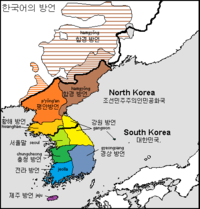Comparison of Japanese and Korean
The geographically proximate languages of
Korean and Japanese have very different
Overview
| Korean | Japanese | |
|---|---|---|
| Speakers | 83 million | 126.4 million |
| Countries | ||
| Family | Koreanic | Japonic |
| Writing | Hangul, Hanja (South Korea), Idu, Gugyeol, Hyangchal (formerly) |
Kana, Kanji, Man'yōgana (formerly) |
Grammar
Korean and Japanese both have an
Vocabulary
The two languages have been thought to not share any cognates (other than loanwords),[4] for their vocabularies do not phonetically resemble each other. There is a minority theory attributing the name of the city Nara to a loanword from Korean (see:
Numerals
Similarities have been drawn between the four attested numerals of Goguryeo, an ancient Korean relative, and its equivalents in Old Japanese.[19][20]
| Numeral | Goguryeo | Old Japanese |
|---|---|---|
| 3 | mil | mi1 |
| 5 | uc | itu |
| 7 | na-nin | nana |
| 10 | dok | to2 / to2wo |
Note: See Jōdai Tokushu Kanazukai for information on Old Japanese subscript notation.
Writing
Both languages use, to some extent, a combination of native scripts and
Korean is mostly written in the Korean
Japanese is written with a combination of kanji (Chinese characters adapted for Japanese) and kana (two writing systems representing the same sounds, composed primarily of syllables, each used for different purposes).[22][23] Unlike Korean hanja, however, kanji can be used to write both Sino-Japanese words and native Japanese words.
Historically, both Korean and Japanese were written solely with Chinese characters, with the writing experiencing a gradual mutation through centuries into its modern form.[24]
Honorifics
Both languages have similar elaborate, multilevel systems of
See also
- Baekje language
- Classification of the Japonic languages
- Classification of Japonic languages#Similarities between Japanese and Koreanic languages
- Japonic languages
- Koreanic languages
- Peninsular Japonic
References
- ^ Andrew Logie (November 22, 2013). "Are Korean and Japanese related? The Altaic hypothesis continued". Koreanology. Retrieved February 17, 2016.
- ^ Kornicki, Peter. Aston, Cambridge and Korea Archived May 29, 2008, at the Wayback Machine
- ^ Poppe 1965:137
- ^ Martin, Samuel(1990).
- ^ Whitman, John (1985).
- ^ E. Riley, Barbara (2004).
- ^ Starostin, Sergei (Moscow, 1991). The Altaic Problem and the Origins of the Japanese Language.
- ^ Georg et al. 1999:72, 74
- ^ "While 'Altaic' is repeated in encyclopedias and handbooks most specialists in these languages no longer believe that the three traditional supposed Altaic groups, Turkic, Mongolian and Tungusic, are related." Lyle Campbell & Mauricio J. Mixco, A Glossary of Historical Linguistics (2007, University of Utah Press), pg. 7.
- ^ "When cognates proved not to be valid, Altaic was abandoned, and the received view now is that Turkic, Mongolian, and Tungusic are unrelated." Johanna Nichols, Linguistic Diversity in Space and Time (1992, Chicago), pg. 4.
- ^ "Careful examination indicates that the established families, Turkic, Mongolian, and Tungusic, form a linguistic area (called Altaic)...Sufficient criteria have not been given that would justify talking of a genetic relationship here." R.M.W. Dixon, The Rise and Fall of Languages (1997, Cambridge), pg. 32.
- ^ "...[T]his selection of features does not provide good evidence for common descent" and "we can observe convergence rather than divergence between Turkic and Mongolic languages--a pattern than is easily explainable by borrowing and diffusion rather than common descent", Asya Pereltsvaig, Languages of the World, An Introduction (2012, Cambridge) has a good discussion of the Altaic hypothesis (pp. 211-216).
- ^ Robbeets, Martine and Bouckaert, Remco. Bayesian phylolinguistics reveals the internal structure of the Transeurasian family Archived July 27, 2020, at the Wayback Machine, Robbeets, Martine et al. 2021 Triangulation supports agricultural spread of the Transeurasian languages, Nature 599, 616–621
- S2CID 249649524
- ^ Bernard Comrie: "Introduction", p. 7 and 9 in Comrie (1990).
- ^ S. Tomlin, Russell. Surveyed in the 1980s.
- ^ Introducing English Linguistics International Student Edition by Charles F. Meyer
- ^ Russell Tomlin, "Basic Word Order: Functional Principles", Croom Helm, London, 1986, page 22
- ^ Shinmura, Izuru (1916). "國語及び朝 鮮語の數詞について [Regarding numerals in Japanese and Korean]". Geibun. 7.2–7.4.
- ^ Yi, Ki-Mun (1972). "Kugosa Kaesol [Introduction to the history of Korean]". Seoul: Minjung Sogwan.
{{cite journal}}: Cite journal requires|journal=(help) - ^ Hannas 1997: 68. "Although North Korea has removed Chinese characters from its written materials, it has, paradoxically, ended up with an educational program that teaches more characters than either South Korea or Japan, as Table 2 shows."
- ^ Advances in Psychology Research. Google Books. Books.google.co.uk. Retrieved on 2013-08-24.
- ^ Learning Japanese in the Network Society. Google Books. Books.google.co.uk. Retrieved on 2013-08-24.
- ^ The Handbook of Korean Linguistics By Jaehoon Yeon
- JSTOR 41913346.
- ^ "Grammaticalization in Sentence-Final Politeness Marking in Korean and Japanese".



